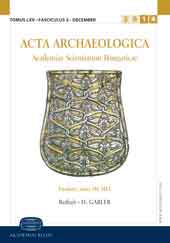DER CUNDPALD-KELCH WEGE UND UMWEGE IN DER FORSCHUNG
THE CUNDPALD CUP. PROGRESS AND DETOURS IN RESEARCH
Author(s): Béla Mikós SzőkeSubject(s): Archaeology, Cultural history, Evaluation research, 6th to 12th Centuries
Published by: Akadémiai Kiadó
Keywords: guilloche ornament; bunch of grapes motive; inscription; Communion chalice; reliquary;
Summary/Abstract: The results of my review of the research of the Cundpald cup from Petőháza from archaeological, art historical and historical aspects are the followings. The cup, which stands the closest to the Bavarian Tassilo cup in its shape and ornamental elements, is similar to the Western Frankish Grimfridus cup regarding its ornamental system, while insular and Northern Italian impulses influenced its continental guilloche ornament. The cup was prepared in one of the monasteries of the Salzburg region in a broader sense. The inscription engraved in the nodus follows a Western Frankish style, but it is not certain that it was engraved into the cup together with the guilloche. The originally travelling or Communion chalice was certainly transformed at a later time; the three (and yet another) perforations under the rim were, however, prepared not as settings of gems but for suspension. The earliest date of the production of the cup is 780–800 but there is a growing number of evidences that it was prepared around 800 or even a few decades later. The cup was used for a long time: initially as a Communion chalice, and later as a reliquary suspended above the altar of a church. Finally, it seems certain that it was not buried in the grave of a dignitary of the church but it got into the Ikva Streamlet among unknown circumstances, where it was found during the regulation of the bed of the streamlet in 1879.
Journal: Acta Archaeologica Academiae Scientiarum Hungaricae
- Issue Year: 59/2008
- Issue No: 2
- Page Range: 347-366
- Page Count: 20
- Language: German
- Content File-PDF

